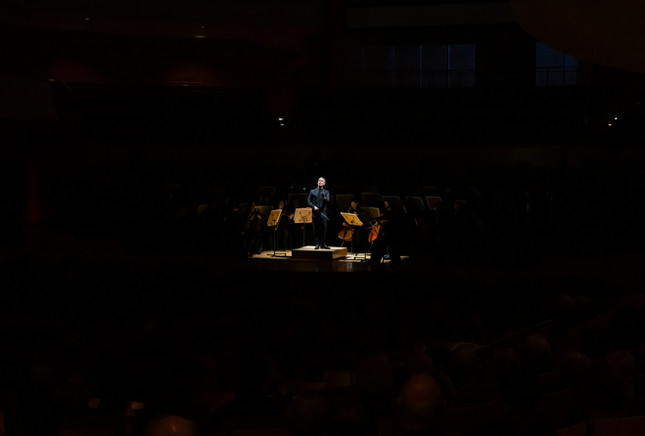Shelley and Pacific Symphony Impress with ‘Daphnis and Chloé’
- Timothy Mangan
- 1 day ago
- 4 min read
Updated: 19 hours ago
REVIEW: Ravel’s complete masterpiece is well served with assistance of Pacific Chorale, though some obstacles remained.

Alexander Shelley, artistic and music director designate of the Pacific Symphony, is showing himself to be a master of orchestral technique. Under his baton, the orchestra sounds fantastically prepared and motivated, like a major ensemble, perhaps better than it ever has before. Like the conductor, the music addressed emerges meticulously well tailored.
For his latest program with the group, heard Thursday night in the Renée and Henry Segerstrom Concert Hall (and scheduled to repeat Friday and Saturday), Shelley chose one of the most demanding and spectacular works in the repertoire to display an orchestra’s and conductor’s wares, Maurice Ravel’s complete ballet, “Daphnis et Chloé.” It was darn impressive.
Not that Shelley wholly overcame the problem with “Daphnis” when presented as a concert work, which is that it’s not a concert work, or at least isn’t entirely successful as one. Ravel himself must have known this when he made two suites from the ballet for concert performance. (The second suite is more often heard in concert than the entire ballet and was indeed a specialty of Carl St.Clair.)
Meanwhile, the music of the complete ballet (when in concert performance) spends much of its time meandering here and there in pursuit of its ancient storyline and cast of characters, including two young lovers, nymphs, gods, shepherds, pirates and a cowherd. Ravel is never less than masterful at doing this, but in concert “Daphnis” becomes something of a catalogue of special effects and instrumental colors rather than a strong, purely musical narrative and cogent symphonic work. Formally, it’s weak, in other words, especially the first two thirds of its 50 odd minutes.

The performance tried to alleviate this in a couple of ways. One was to present the music with supertitles, an excellent idea. A listener could follow the storyline point by point and understand what Ravel was doing in the music with it and admire its aptness and brilliance.
Another alleviator was Shelley’s tempos and phrasing. The man (who conducted this complex music without score) is no dawdler, and he never lets a phrase droop or lag. The flow was always controlled. I thought a few of his tempos were too fast (for the Introduction, the “Lever du Jour” and the final “Danse générale,” which was nevertheless thrilling), but better that than too slow.
The large contingent of Pacific Symphony musicians sparkled, glittered, glowed and exploded. The woodwinds were nicely placed in the forefront of the sound picture, and principal flutist Benjamin Smolen was at his best. The Pacific Chorale (there’s a wordless choir) gleamed with its ohs and ahs, perfectly balanced. At one point, when the god Pan appears, a contingent of the choir was positioned high in a balcony behind us; the lights went down on stage with only a spot on Shelley. He turned and conducted facing us, an effective theatrical moment.
Members of the Pacific Chorale sing part of the concert from high in the balcony, behind the audience. In a dramatic moment, Shelley conducts from a single spotlight during the performance. Photo courtesy of Pacific Symphony/Doug Gifford
In the first half of the program, we were introduced to the Piano Concerto No. 1, “Latin Concerto” by Gabriela Montero, who was also the authoritative pianist on this occasion. The Venezuelan musician has written a readily accessible and easily likable work that doesn’t preclude sophistication, a mix, say, of Ginastera, Gershwin and bebop.
It is comprised of a Mambo, an Andante Moderato (a melancholy song, put through intensifying variations) and an Allegro Venezolano (with a touch of Prokofiev), all put together with a performer’s expertise, i.e. for what is effective with an audience, not just other musicians. She played it with easy grace and almost matter of fact virtuosity. Shelley and the orchestra accompanied her with ready understanding of the jazz and Latin stylings.
PHOTO 1: Gabriela Montero, at the piano, plays with the Pacific Symphony. PHOTO 2: Montero and Shelley take a bow with the full orchestra. Photo courtesy of Pacific Symphony/Doug Gifford
Well known for her gifts at improvisation, Montero did just that for her encore. She asked for someone in the audience to sing a tune; someone sang the first bit of “The Sound of Music,” and Montero went off headlong with it, forging a kind of (impressive) Rachmaninoff etude with never a hesitation throughout.
The concert began with the Suite No. 1 from “Carmen” by Bizet. It’s good, familiar music, a nice concert opener, and was played with alert rhythms and polished orchestral surfaces, even if (again) a few tempos could have relaxed a little. Shelley has a gift for what used to be called the light classics. We must get him to play some Rossini overtures, which these days are rather neglected.
Shelley Conducts Carmen and Daphnis and Chloé
Alexander Shelley leads the Pacific Symphony in Bizet’s Carmen Suite No. 1; Ravel’s “Daphnis and Chloé,” featuring the Pacific Chorale; and “Latin Concerto,” by Gabriela Montero, who will join the orchestra as piano soloist.
When: 8 p.m. Friday-Saturday, Nov. 21-22.
Where: Renée and Henry Segerstrom Concert Hall, 600 Town Center Drive, Costa Mesa
Tickets: $36–$252
Information: 714-755-5799 or visit pacificsymphony.org






















_gif.gif)


%20(1)_gif.gif)